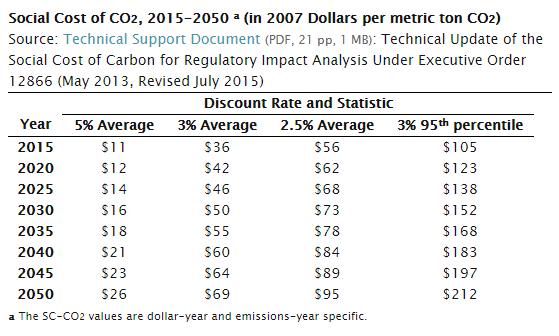 Jessica Wentz
Jessica Wentz
Associate Director and Fellow
Tucked deep into the opening brief on procedural and record issues filed by opponents to the Clean Power Plan there is an important and under-reported development: The role of the Social Cost of Carbon (SCC) in cost-benefit analysis is now before the D.C. Circuit Court of Appeals. Petitioners in West Virginia v. EPA have argued that the cost-benefit analysis underlying the plan is “fundamentally flawed” because the Environmental Protection Agency (EPA) used the SCC to estimate the benefits of greenhouse gas (GHG) emission reductions. This is only one of many arguments raised by petitioners, but it is noteworthy insofar as it illustrates just how little deference they think the court should afford EPA. But EPA’s use of the SCC to calculate the costs and benefits of the nation’s most significant GHG regulation to date not only makes sense, it is arguably required by law. Read my explanation of why that is after the jump.
The SCC is a tool developed by the federal government to estimate the costs of GHG emissions that are either released or avoided as a result of agency rulemakings. It provides a comprehensive estimate of climate change damages, including changes in net agricultural productivity, human health, property damages from increased flood risk, and changes in energy system costs. (Details on how it is calculated are available here.)
As illustrated in this chart, the SCC is expressed as a range of possible costs associated with the release of one ton of carbon dioxide (CO2) in a particular year:
The first three columns in the table above reflect the estimated cost of CO2 emissions under different “discount rates” (the idea being that future harms are “discounted” to reflect the present value of those harms). The fourth column—the 95th percentile estimates—reflects a “high risk” scenario where actual harms, expressed as costs, exceed the predicted average costs. The calculations behind the values in these columns were arrived at through a transparent and open interagency process and reflect peer-reviewed science and economic analysis.
EPA has used the SCC to calculate the economic impacts of CO2 emissions and reductions associated with its rulemakings since 2010. Other agencies now also routinely use the SCC to monetize the GHG impacts of their rulemakings and other actions. There are also two federal court decisions requiring agencies to assign a dollar value to CO2 emissions when conducting cost-benefit analysis. The first decision—Center for Biological Diversity v. NHTSA—held that it was arbitrary and capricious for an agency to ignore the impacts of GHG emissions in a regulatory impact analysis, even when there is uncertainty about those impacts: “[W]hile the record shows there is a range of values, the value of carbon emissions reduction is certainly not zero.” The second decision—High Country Conservation Advocates v. USFS—specifically required the use of the SCC in a cost-benefit analysis underpinning the approval of federal coal leases. These cases have put agencies on notice that they must use the SCC when evaluating the costs and benefits of rulemakings and other types of actions.
Despite this precedent, the petitioners in West Virginia v. EPA assert that EPA’s use of the SCC to monetize the benefits of CO2 emission reductions under the Clean Power Plan is arbitrary and capricious. They argue that the SCC inflates the social benefits of the Plan, that its flaws are “well known,” and that “EPA’s reliance on this flawed tool is fatal.” To support their argument, they misrepresent statements made by the Department of Interior (DOI), the National Academy of Sciences, and an economics professor.
First, the petitioners assert that DOI considers the SCC to be “misleading” because it excludes “the social benefits of energy production.” They cite an Environmental Assessment for two federal coal leases in which DOI had not conducted any cost-benefit analysis and thus concluded that it would be misleading to assign a dollar value to the impacts of GHG emissions while ignoring other costs and benefits. DOI’s statement about using the SCC in this context is irrelevant to the question of whether the SCC should be used in the context of a complete cost-benefit analysis like that performed for the Clean Power Plan.
Second, the petitioners claim that the National Academy of Sciences considers the SCC to be “outdated, inaccurate and uncertain.” They cite to a recent report in which the National Academy of Sciences actually concluded that there was no need to update the SCC in the near-term. The report contained recommendations on how uncertainty about SCC estimates should be presented in regulatory documents, but these recommendations were intended to support the ongoing use of the SCC by federal agencies like EPA. Nowhere does the report criticize or question the use of the SCC as a federal decision-making tool.
Third, the petitioners assert that “academics” have characterized the SCC as “meaningless,” “close to useless,” and “arbitrary,” citing one article from Professor Robert Pindyck. Notably, Professor Pindyck ultimately concluded in the same article that “even though we don’t have a good estimate of the SCC, it would make sense to take the [federal government’s] number as a rough and politically acceptable starting point” for valuing the cost of CO2 emissions. Moreover, unlike the petitioners who assert that the SCC overestimates the cost of GHG emissions, Professor Pindyck is concerned that the SCC does not adequately convey the risk of catastrophic impacts. For example, in a 2015 article, he recommended that we “focus more on the unlikely but devastating scenarios” that could occur as a result of climate change, and this “might lead to an SCC as high as $200 per ton.” Other scientists have also concluded that the SCC underestimates the potential costs of climate change (one recent study estimated that the correct value was $220 per ton).
So, none of the sources relied upon by the petitioners actually support their argument, and the manner in which they have quoted these sources is misleading. Of course, there is uncertainty about the future damages caused by CO2 emissions, but this does not mean we should ignore those damages altogether. EPA must assign a dollar value to CO2 emission reductions in its cost-benefit analysis, and the SCC is widely accepted as a reasonable (albeit conservative) estimate of that value. EPA’s decision to use the tool is further bolstered by the fact that the agency has decades of experience with the valuation of uncertain environmental and social costs—in other words, this type of analysis falls squarely within the agency’s realm of expertise.
The petitioners also argue that the Clean Air Act “expressly forecloses” the use of global SCC values in the cost-benefit analysis because the scope of this analysis should be limited to national economic impacts and only 10% of the estimated benefits from CO2 reductions will accrue to the United States. But the petitioners do not cite any provision of the Act which expressly forbids EPA from considering global impacts when conducting a cost-benefit analysis for a rulemaking. Even accepting the petitioners’ logic, the total economic benefits of the rule still significantly outweigh the costs, due to co-benefits from reductions in conventional air pollutants (see page ES-22 of the regulatory impact analysis).
Although there are considerable uncertainties about the economic impacts of CO2 emissions there really is no question that the value of CO2 emission reductions should be accounted for in cost-benefit analysis. The SCC is the best available tool for estimating those economic impacts, and it includes a range of possible values in order to account for uncertainty. EPA’s reliance on the tool accorded with recent federal practice, and should be upheld by the court.
If the court were to agree with the petitioners on this issue, what would be the result? It is hard to imagine the court would require EPA to simply ignore the costs of CO2 emissions—such an omission really would be arbitrary and capricious. The more likely result would be a remand to EPA for further analysis and possible revision of the SCC. This would accomplish little other than delaying the rulemaking process and creating considerable uncertainty for all federal agencies about the value they should to assign to CO2 emissions when conducting cost-benefit analyses for other rules and actions. It would also be a prime example of judicial overreach into precisely the sort of technical matter that should be left to an administrative agency.



